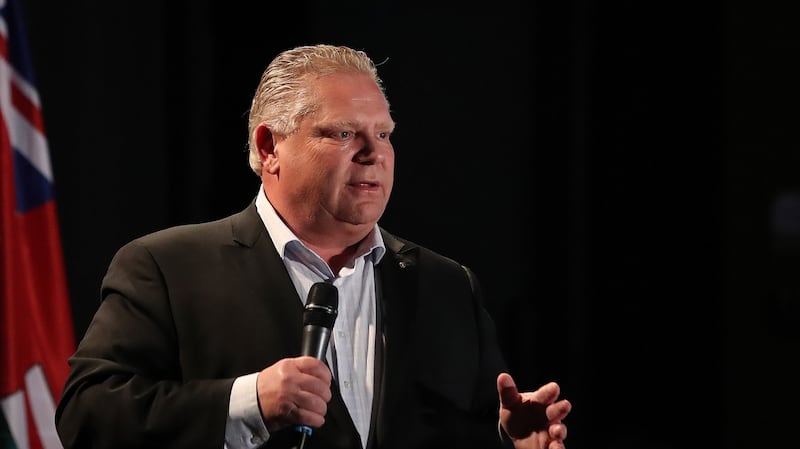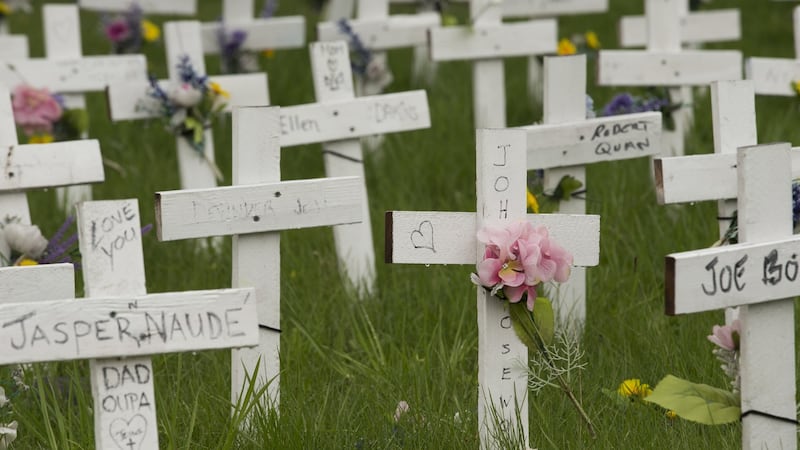As the US has seemed to get a grip on its Covid-19 crisis, Canadians have been angered by a chaotic government response that has allowed a third wave to take hold and led to a delayed vaccine rollout.
It is a contrast driven home by the fact that Canada’s case count, when adjusted for population, now exceeds that of the US for the first time since the pandemic began.
"It's such a reversal of how we felt as Canadians for the last four years of Donald Trump, " said David Coletto, chief executive of Abacus Data, a polling firm. "It's a bizarro world for us to now look down south and say: 'What do you mean they're doing better than us?'"
While there are hopeful signs that Canada has turned a corner in the fight against its steepest wave of Covid-19 cases, hospitals in the country's largest city of Toronto are at full capacity and health officials are nervously watching the spread of a variant first identified in India.
"The current plateau is very precarious," said Dr Adalsteinn Brown, co-chair of the Ontario government's Covid-19 Science Advisory Table during a presentation Thursday. "This is a place where you can either start to drive down the pandemic ... or if we see a change [in lockdown measures], as we have seen in the past we could see substantial exponential growth and really a continuation of the third wave or a fourth wave."
Cases of Covid-19 have risen right across Canada during its third wave but the hardest-hit provinces are Alberta in the west and Ontario, the most populous.
Alberta introduced fresh restrictions last week after reporting a record high 2,430 new cases, with Ontario reporting 3,370 on Saturday. The seven-day average in that province peaked on April 17th at 4,370. Ontario also reported 900 patients in intensive care, its highest figure since the start of the pandemic.
At least one Toronto hospital began moving patients to other hospitals in the past few days because of dwindling oxygen supplies.
Third wave
Ontario's premier, Doug Ford, has in recent months overseen a shambolic pandemic response that has whipsawed for businesses and residents. After declaring the province's second state of emergency in January, he then pushed for Ontario's economy to reopen throughout February as cases and hospitalisations fell.

The province allowed restaurants to reopen to patio dining in late March, only to reverse course two weeks later as the third wave took hold. Restaurants Canada, a lobby group, estimates that businesses spent C$100 million (€67 million) preparing for the aborted reopening.
Ford’s government declared a third state of emergency two weeks ago and imposed new social curbs, including shutting playgrounds and authorising arbitrary police stops of residents. A fierce backlash forced the premier to reverse both measures within days. “We got it wrong,” he told reporters while choking back tears.
Health officials say the government’s continued focus on restricting outdoor activities such as golf, tennis and camping is misguided because workplaces and indoor spaces have seen the most outbreaks.
Last week, after months of pleading from doctors, Ford’s government introduced a sick-pay plan that will compensate workers up to C$200 (€135) a day for three days to encourage them not to return to work if they are unwell.
Experts say the measure will not be enough, given the length of time it takes to recover from Covid-19 or to quarantine after an exposure. "It's tokenism," said Dr Ashleigh Tuite, an epidemiologist at the University of Toronto. "Having three days is better than no days but if you want to do this in a way that would be meaningful, it needs to be a minimum of 10."
Ontario’s third wave has been made worse by a vaccine rollout that was slow to start and has been mired in finger-pointing between the province and Justin Trudeau’s federal government.
Critics say Trudeau’s government was too slow to sign agreements with vaccine makers and did not move fast enough to secure domestic manufacturing capacity. The federal government has in turn accused provinces such as Ontario of leaving too many doses sitting in fridges.
Vaccinations
When Canada fell behind many other countries in administering doses earlier this year, it adopted a strategy similar to that of the UK in which second doses of vaccines are delayed by several months.
As a result, 32 per cent of Canada’s population has received one dose, putting it in third place among major economies. However, only 2.9 per cent are fully vaccinated, compared with 21 per cent in the UK and 30 per cent in the US.
"We're seeing patients come into hospital quite sick after they've had their first dose and some of them well beyond the first two weeks when it becomes effective," said Dr David Jacobs, chair of the Ontario Specialists Association and a vocal critic of Trudeau on social media.
“So we’ve neither managed to get herd immunity with the volume of vaccines we’ve received and nor have we protected individuals with only one dose. Trudeau has failed on both fronts.”

In recent days Ford has focused his criticism on Trudeau’s handling of Canada’s border controls, which allowed more contagious variants to gain a foothold. As of this week, 90 per cent of coronavirus cases in the country are the B.1.1.7 variant, which first emerged in the UK. Public Health Ontario has recorded three dozen cases of the variant first detected in India.
"Last week the Indian variant was reported in Ontario," Ford said on Friday. "I can tell you it didn't swim here." On April 22nd the Trudeau government bowed to pressure and suspended flights from India and Pakistan.
Ford has since called on Trudeau to require anyone entering Canada by land from the US to face a three-day mandatory quarantine in a government-approved hotel, which is currently only required for people arriving by air. He pointed to reports of international travellers flying to US airports and either walking or taking taxis into Canada.
Trudeau on Friday said his government was considering the request but suggested existing safeguards such as testing and self-quarantine rules were working.
So far, it is Ford who is paying the steepest price politically for the third wave. A survey by Abacus Data found the share of Ontario’s population with a positive impression of Ford had fallen from 39 per cent in mid-April to 28 per cent last week.
“For most of the pandemic people felt he was doing as good a job as he could with his ‘Aw shucks’, Uncle Doug approach,” said Coletto. “With the third wave, people started to ask why it got so bad and they’re more likely to blame him.” – Copyright The Financial Times Limited 2021















